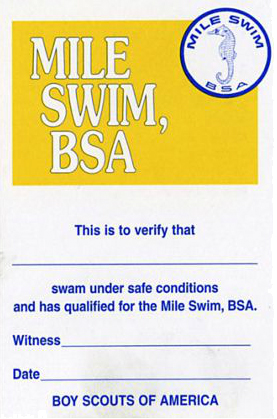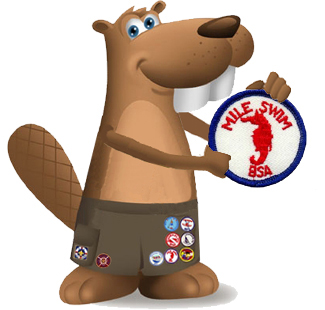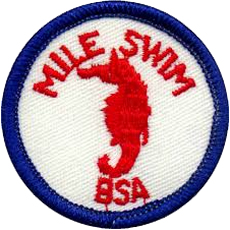Mile Swim BSA
Regular exercise is an important contributor to a long and healthy life. For example, exercise lowers several risk factors for heart disease. People who exercise regularly are much less likely to be overweight. Not only does exercise burn calories, it may actually suppress appetite. Blood pressure is reduced by exercise. The combination of exercise and weight reduction often allows people with hypertension to control their blood pressure without the use of medication. Smokers commonly discontinue that habit as they begin exercise programs. Active joggers tend to have lower total cholesterol than those who do not run. When it comes to protecting your heart, there is no substitute for exercise.
Without sufficient exercise, bones become demineralized. They lose calcium and become brittle. Demineralization can progress rapidly in those who are bedridden and cannot exercise. Demineralization is a concern for astronauts since lack of gravity robs activity of its exercise value. Weak and brittle bones, caused by lack of exercise, are common in senior adults.
Exercise is an excellent cardiovascular conditioner and important to living better as well as longer. People who exercise regularly feel and look younger than those who do not. Improvements in muscle tone and circulation undoubtedly contribute to freedom from fatigue and the feeling of well-being that the physically fit enjoy.
Swimming is to some degree superior to other forms of exercise because it is a full-body exercise (all muscles and joints are exercised) and because it avoids the risk of damage to joints and other parts of the body that may result from activity such as running. The extensive use of swimming therapy for the injured and impaired is further evidence of its value as a body conditioner.
The Mile Swim BSA recognition provides a sense of accomplishment and supports confidence, safety, skill, and physical fitness. The ability to swim long distances in warm water in time of need provides a margin of safety for all aquatics activities. Swimming skills and physical stamina are also needed to assist others. In addition to safety, Mile Swim BSA should encourage the development of physical fitness by introducing youth to swimming as regular exercise. However, it is not a competitive training program limited to specific strokes that emphasize speed over efficiency. Swimming skills, including mastery of restful strokes, are as important to the program as endurance. Anyone who can walk a mile without stopping should have sufficient stamina to swim a mile with restful strokes. Just as walking is a viable exercise alternative to jogging or sprinting, restful swimming strokes used over long distances in place of a fast crawl can also play a positive role in physical conditioning.
Counselors for Mile Swim BSA must be approved by the council. Adults trained as a BSA Aquatics Instructor, a Red Cross Water Safety Instructor, or a YMCA Swim Instructor are good candidates. Swim coaches with a Scouting background are also appropriate. All counselors must have current Safe Swim Defense training.
All in-water exercises must conform to Safe Swim Defense guidelines. The requirements specify that the participant first prepare before swimming a continuous mile. Four sessions of an hour each are appropriate. Each session should include a discussion of objectives, warm- up, stroke tips, and swims for increased distances. Short sprints may be included to illustrate different levels of aerobic exercise. The groundwork sessions are intended to ensure the success of all applicants who begin with reasonable swimming skills. The goal is encouragement and skill refinement, not elimination. Virtually all of those who participate in the training should be able to complete the mile, particularly if they are shown how to refine the crawl stroke using rhythmic breathing with the head in the water and to use alternative restful strokes such as the elementary backstroke, the breaststroke, and the sidestroke that utilize a relaxed pace and a glide.
The training sessions may be conducted separately or in combination with another program, such as instruction for the Swimming merit badge. Credit may be given anyone, such as a swim-team member, who provides evidence of regular participation in a supervised swim training or fitness program that covers at least four hours over four different, regularly scheduled sessions.
The continuous mile may be done using any combination of strokes and has no time limit. The swimmer may pause in deep water either by floating or treading water but may not rest by standing or holding to the side. Both open and flip turns are allowed in pools.
The mile may be covered by laps in a pool or at an enclosed waterfront swimming area.
Courses over extended distances in open water must conform to Safe Swim Defense guidelines regarding hazards such as submerged trees, currents, or boat traffic, as well as water quality, depth, and clarity.
Each individual swimmer, or at most a buddy pair, may be accompanied by a rowboat with two people onboard, one skilled in controlling the boat and the other trained in basic water rescue, equipped with a reaching device and a flotation aid, continuously watching the swimmer(s). The swimmer, not the boat, must set the pace.
Alternatively, a closed circuit may be established where all swimmers are constantly in reach of safety personnel strategically positioned at fixed points on anchored boats, the shore, or piers. Each participant swims with a buddy, and the number and spacing of those in the water should not exceed the capacity of the watchers to easily count the swimmers as they move from one zone to another.
Swimsuit / swim trunks emblem – The Mile Swim BSA patch is NOT worn on the uniform or the sash; it is worn on the left side of the swimsuit / swim trunks
Mile Swim BSA Award
Upon successful completion, participants earn the Mile Swim BSA patch along with their achievement card. Completion indicates the individual has experienced a valuable introduction to distance swimming.

Mile Swim BSA Requirements

Mile Swim BSA – Forms, Links, and Resources
Aquatics Supervision – Leader's Guide – the Mile Swim BSA award application is contained in the appendix.

